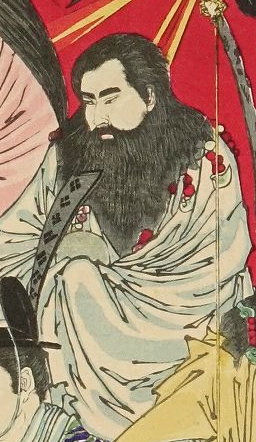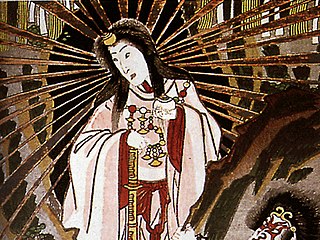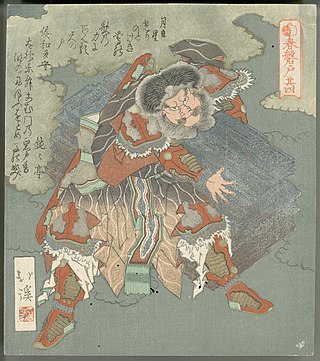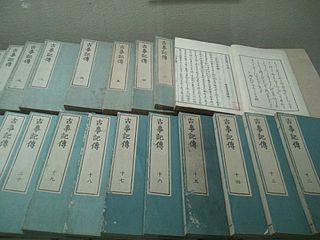Ame-no-Koyane-no-mikoto is a kami and a male deity in Japanese mythology and Shinto. He is the ancestral god of the Nakatomi clan, and Fujiwara no Kamatari, the founder of the powerful Fujiwara clan. An Amatsukami, 'Kami of heaven', he resides in Takamagahara.

Ninigi-no-Mikoto is a deity in Japanese mythology. Grandson of the sun goddess Amaterasu, Ninigi is regarded according to Japanese mythology as the great-grandfather of Japan’s first emperor, Emperor Jimmu. The three sacred treasures brought with Ninigi from Heaven and divine ancestry established the Japanese Imperial Family.

Ama-no-Iwato is a cave in Japanese mythology. According to the Kojiki and the Nihon Shoki, the bad behavior of Susano'o, the Japanese god of storms, drove his sister Amaterasu into the Ama-no-Iwato cave. The land was thus deprived of light.

In Japanese mythology, Takamagahara, also read as Takaamanohara, Takamanohara, Takaamagahara, or Takaamahara, is the abode of the heavenly gods (amatsukami). Often depicted as located up in the sky, it is believed to be connected to the Earth by the bridge Ame-no-ukihashi.

Sumiyoshi-taisha (住吉大社), also known as Sumiyoshi Grand Shrine, is a Shinto shrine in Sumiyoshi-ku, Osaka, Osaka Prefecture, Japan. It is the main shrine of all the Sumiyoshi shrines in Japan. However, the oldest shrine that enshrines the Sumiyoshi sanjin, the three Sumiyoshi kami, is the Sumiyoshi Shrine in Hakata.

Futsunushi, also known as Iwainushi, is a warrior god in Japanese mythology. Also known under the epithet Katori Daimyōjin (香取大明神) after his shrine in northern Chiba Prefecture, Katori Jingū, he is often revered alongside Takemikazuchi, with whom he is closely associated. He is regarded as a legendary ancestor of the Mononobe clan, and like Takemikazuchi is one of the tutelary deities of the Fujiwara clan.
Nakatomi clan was a Japanese aristocratic kin group (uji). The clan claims descent from Amenokoyane.
Kogo Shūi (古語拾遺) is a historical record of the Inbe clan of Japan written in the early Heian period (794–1185). It was composed by Inbe no Hironari (斎部広成) in 807 using material transmitted orally over several generations of the Inbe clan.
Ame-no-Minakanushi is a deity (kami) in Japanese mythology, portrayed in the Kojiki and the Nihon Shoki as the first or one of the first deities who manifested when heaven and earth came into existence.

Awa Shrine is a Shinto shrine in the Daijingū neighborhood of the city of Tateyama in Chiba Prefecture, Japan. It is one of two shrines claiming to hold the title of ichinomiya of former Awa Province. The main festival of the shrine is held annually on August 10.

Sarutahiko Ōkami is a deity of the Japanese religion of Shinto; he is the leader of the earthly kami. Norito also mentions him with the title Daimyōjin instead of Ōkami. Sarutahiko Ōkami was the head of the kunitsukami and in the Jinnō Shōtōki is said to have been the ancestor of Otanomikoto.

Takemikazuchi (建御雷/武甕槌) is a deity in Japanese mythology, considered a god of thunder and a sword god. He also competed in what is considered the first sumo wrestling match recorded in history.

Ame-no-tajikarao (アメノタヂカラオ) is a Japanese deity (kami) who appears in Japanese mythology. Ame-no-tajikarao is written as 天手力男神 in Kojiki, and 天手力雄神 in Nihon Shoki. Tajikarao's name means heaven hand power.

Futodama is a god in Japanese mythology, claimed to be the ancestor of Imbe clan, whose characteristics are believed to reflect the functions of the clan as court ritualists.
Kamuyaimimi (神八井耳命), is a figure in Japanese mythology and one of the three brothers born to Emperor Jinmu and his wife Himetataraisuzu-hime. He is best known for his role in the Assassination of Tagishimimi, in which he and his brother Suizei killed Tagishimimi in order to protect Suizei from assassination.

Himetataraisuzu-hime(媛蹈鞴五十鈴媛) is a Japanese goddess, a mythological figure in the Nihon Shoki, the first empress of Japan, and the first wife of Emperor Jimmu.

Tsukiyomi Shrine is a Shinto shrine located in Nishikyō Ward, Kyoto, Japan. It was named as a Myōjin Taisha in the ancient Japanese religious book Engishiki. Tsukiyomi Shrine is one of the "Matsuo Seven Shrines" (松尾七社), and a subsidiary shrine of Matsunoo Taisha 400 meters to the north. Its annual festival is on October 3.

The main two books are the Kojiki and the Nihon Shoki. collectively called the Kiki (記紀)

Susaki Shrine is a Shinto shrine in the Susaki neighborhood of the city of Tateyama in Chiba Prefecture, Japan. It is one of two shrines claiming to hold the title of ichinomiya of the former Awa Province. The main festival of the shrine is held annually on August 20.

Inbe Shrine is a Shinto shrine located in Tokushima, Japan.















